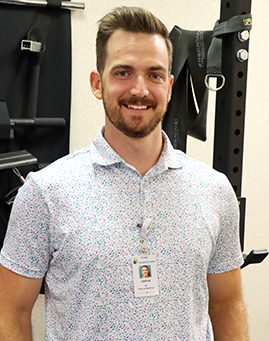Physical therapy helps runners get back on track following injuries
Fitness, Orthopedics
Following a running injury, what do you typically do? Maybe you rest. Maybe it’s a combination of ice and heat applied to the sore spot.
Have you ever thought about physical therapy?
St. Joseph’s/Candler has five outpatient rehabilitation centers that offer unique services, including physical therapy for running injuries.

“It starts with an evaluation to see how they are feeling and how the injury may have occurred. Running injuries present differently in different people,” explains Josh Frey, physical therapist at St. Joseph’s Outpatient Rehabilitation Center. “We also do a run analysis, where we watch you run on a treadmill or in the clinic to pick up on things you may not have even noticed.”
There are a number of injuries that can occur due to running. Five common types of injuries are:
- Runner’s knee, or patellofemoral pain syndrome: Irritation of the cartilage behind the knee cap. This condition occurs more often in females because the angle of the femur from a wider hip may change the alignment of the knee cap.
- Achilles tendonitis: Inflammation and pain from injury or inflammation of the Achilles tendon at or above the heel bone.
- Plantar fasciitis: Inflammation/injury to the plantar fascia or broad ligament that runs under the arch from heel to ball of the foot.
- Shin splints: Can be a number of things such as a stress fracture of the tibia, tendinitis of the muscles that attach to the inner portion of the tibia, or in rare cases compartment syndrome where pressure builds up from exertion of the muscle within the capsule of the inner lower leg.
- Iliotibial (IT) band syndrome: Pain from the frictioning of the band of tissue that runs from the outer hip bone to the knee.
What causes an injury while running can vary from person to person. One common reason, Frey says, is overuse of the certain muscle or tendon. A running injury also can occur because of a previous injury, especially if it is a nagging issue not addressed. Other times, a runner may try to go too hard or too fast before their body is ready.
Lack of flexibility or strength, improper or worn footwear and training errors are other reasons injuries occur.
“It’s important to not ignore flexibility and strength, and you should spend a couple days a week on that in addition to running,” Frey says. “Proper footwear is important, and that’s something we can help address as well.”
Related Article: Are you exercising in the right pair of shoes?
The patient experience
For those that choose physical therapy to treat a running injury, patients can first expect an evaluation appointment in which the therapist will ask questions about your injury and symptoms and gauge your running, strength and flexibility, Frey says. From there, they will develop a treatment plan that will include individualized exercises to address any deficits. The client also may receive hands-on therapy to assist in mobilizing injured or restricted tissues, and the use of ice, heat or possibly electrical stimulation to control pain, stiffness or swelling.
In addition to treating your injury, your physical therapist will also help figure out why the injury happened in the first place and recommend ways to prevent it from happening again.
“Runners are going to run, so we need to address the cause of the injury to prevent another injury,” Frey says. “During treatment, as you are getting better, we also can safely show you how to return to running and safely increase your mileage and speed.”
The length of treatment varies from patient to patient, but typically averages six to eight weeks. You will also be given home exercise to help continue your improvement.
A doctor’s referral is required for a physical therapy appointment. We have outpatient physical therapy locations at St. Joseph’s Hospital and Candler Hospital, as well as offices in Pooler, Rincon and at The Landings Club. Visit our website for more information or to request an appointment.
“You never want to ignore an injury to the point where you can no longer ignore it,” Frey says. “If running is something you love to do and want to do for a long time, physical therapy is only going to help you accomplish that goal.”
Guide To Stretching for Runners
*Perform all stretches slowly, without bouncing motion. Hold stretches for 30 seconds and repeat. Ideally, you should do a 10-minute warm-up and then stretch. Stretching after a run or any exercise is always recommended.
Hamstring stretch: Start by standing and propping your foot of the affected leg on a chair or step. Next, slowly lean forward until a stretch is felt behind your knee/thigh. Bend through your hips and not your spine. Hold, then return to starting position and repeat. Perform stretch on both legs.
Gluteal stretch: In a seated position, place ankle on opposite knee. Push on knee downward until a comfortable stretch is felt. Perform stretch on both legs.
Gastrocnemius and Soleus stretch: Standing with the involved leg back and the heel on the floor, lean toward the wall until you feel a stretch in the calf. Perform with the knee strait as well as with the knee slightly bent. Perform stretch on both legs.
Iliotibial band stretch: In a standing position, cross the affected leg behind your unaffected leg. Next, with your arm overhead, lean to the side towards the unaffected leg. Switch positions to stretch both sides.
Hip flexor stretch: Take a knee with one knee down and the other foot out in front at 90 degrees. Lean forward leading with your hip until you feel a good stretch in front of thigh. Switch positions to stretch both sides.
Quadriceps stretch: While in a standing position, bend your knee back behind and hold your ankle/foot. Next, gently pull your knee into a more bent position. Perform stretch on both legs.